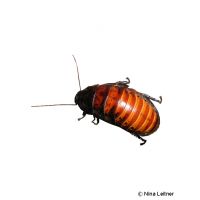Madagascar Hissing Cockroach (Gromphadorrhina portentosa)
| Madagascar Hissing Cockroach Gromphadorrhina portentosa | |
|---|---|
| Name | Madagascar Hissing Cockroach |
| Name Lat. | Gromphadorrhina portentosa |
| Family | Blaberids |
| Family lat. | Blaberidae |
| Order | Cockroaches |
| Order lat. | Blattodea |
| Origin | Africa |
| Habitat | Forest |
| Diet | Fruits, veggies, leaves |
| Humidity | 50-60 % |
| Behavior | Peaceful, nocturnal |
| Keeping | Group |
| Care Level | Easy |
| Housing | Semi humid terrarium |
| Breeding | Simple |
| Life Span | 3-4 years |
| Protection | No |
| Metric Units | |
| Size | 6-8 cm |
| Temperature Day | 25-30 °C |
| Temperature Night | 20-25 °C |
| Housing Size | 50 x 30 x 30 cm |
| US Units | |
| Size | 2.4"-3.1" |
| Temperature Day | 77-86 °F |
| Temperature Night | 68-77 °F |
| Housing Size | 20" x 10" x 10" |
Distribution and habitat
The distribution area of the nocturnal Madagascar Pawpaws are the warmer coastal regions in the east of the island of Madagascar. They prefer to live in dry tree and shrub forests, where they are often found in larger groups in the undergrowth, under the loose bark of dead trees and in the leaf layer on the ground.
Maintenance
A terrarium of 50 x 30 x 30 cm (L x W x H) is recommended for a group of up to 30 animals. A hinged lid terrarium or an aquarium with a tightly closing lid made of the finest gauze is best suited, because the young cockroaches are escape artists. The terrarium should be placed in a quiet place without sunlight.
They need a terrarium structured with numerous climbing branches and cork tubes or egg cartons (hiding places and privacy screens)
Unfertilized soil or bark mulch is suitable as substrate (5-10 cm high), covered with foliage, which serves as additional hiding place and food. A small part of the substrate must always be kept slightly moist, for which e.g. plates of sphagnum moss are well suited. Waterlogging and mold must be avoided at all costs, as the animals prefer to stay in the substrate.
| Temp. day: 25-30 °C | Temp. night: 20-25 °C | Humidity: 50-70 |
The lighting duration should be 8-10 hrs. Daylight fluorescent tubes supplemented with spotlights are ideal.
Diet
Cockroaches are omnivores. A combination of vegetables, fruit and some animal protein is best. Carrots, lettuce, zucchini, apples and oatmeal mixed with dry dog or cat food as a supplementary food are particularly suitable. Special care should be taken to feed only unsprayed and well washed fruits and vegetables. They also eat fresh and dry leaves from various deciduous trees
A varied diet promotes health and prevents deficiency symptoms.
Reproduction and breeding
The males are well recognizable by their two "horns" on the neck shield. The females are usually more massive with thick abdomens. The dominant males are territorial and drive away smaller or weaker males. Occasionally they will bite off limbs of inferior opponents
They are viviparous (ovoviviparous). After fertilization, females form a thin-walled ootheca (egg capsule) that is stored in their genital pocket. There, after about 2-3 months, the fully developed nymphs hatch. One ootheca contains 30-40 eggs, when the nymphs hatch they are about 5 mm in size. After 5-10 months, depending on temperature and diet, they are fully grown and sexually mature
Important
Cockroaches get their name from the hissing sound they emit when in danger, touched, and also for communication. To do this, they quickly squeeze the air out of their breathing orifices
They do not have wings and cannot fly, but they are excellent climbers and very strong, so the cover must close tightly and without gaps to avoid being pushed open by the animals.
The terrarium must have good ventilation without drafts and meet the species specific needs. Measuring devices such as thermometers, hygrometers, etc. are necessary. The lighting has to correspond to the species-specific day-night rhythm and has to be placed in such a way that the animals cannot injure themselves. The terrarium should be locked in such a way that neither unauthorized persons can open it nor the animals can escape. Special attention must be paid to thorough hygiene and impurities must be removed regularly.
Further literature can be found in your pet store.
References
Text: Nina Leitner; Image: Nina Leitner
Source: HENKEL & SCHMIDT (2010): Taschenatlas Wirbellose für das Terrarium, Ulmer Verlag; ENGELMAN & LANGE (2011): Zootierhaltung - Tiere in menschlicher Obhut: Wirbellose, Verlag Harri Deutsch
